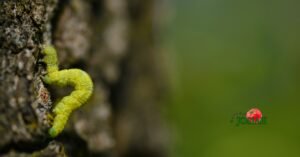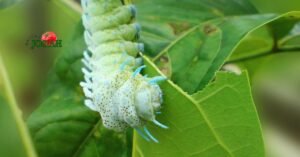Did you know that over the past century, insects like butterflies and moths (Lepidoptera) have seen big drops in population? Climate change is a big reason for this1. Lepidoptera are very diverse and widespread, making them great for studying climate change’s effects on ecosystems1. This article will explore how climate change is changing the world of green caterpillars and their roles in nature.
Key Takeaways
- Lepidoptera, including butterflies and moths, are highly sensitive to climate change and serve as valuable indicators of environmental impacts.
- Climate change is affecting Lepidoptera at multiple scales, from individual genetics to entire communities, resulting in population declines, local extinctions, and range shifts.
- Genetic adaptations and physiological responses, such as those involving the Pgi gene, play a crucial role in how Lepidoptera species respond to rising temperatures and other climate-driven changes.
- Phenological shifts, including earlier emergence and extended flight periods, are observed in Lepidoptera species as they adapt to a warming climate, potentially leading to disruptions in host plant synchrony.
- Understanding the trends and observations of how climate change affects green caterpillars and other Lepidoptera can inform conservation efforts and help maintain the ecological balance in diverse habitats.

Introduction to Lepidoptera as a Model for Climate Change Research
Lepidoptera, which includes butterflies and moths, are widely studied and diverse. They are perfect for studying climate change2. As ectotherms, they regulate their body temperature in various ways. This makes them great for understanding climate change’s effects on species ecology3.
Lepidoptera’s Diversity and Sensitivity to Climate Change
The order Lepidoptera is huge in Europe, with 8470 species in 35 countries2. It’s also the second largest and most diverse in Insecta, with over 150,000 species3. Some species are struggling with climate change, but others are doing well. This shows how different life-history traits can affect their success.
Importance of Studying Climate Change Impacts on Lepidoptera
Studying Lepidoptera helps us find ways to protect species and manage habitats2. They quickly respond to environmental changes because of their short life cycles and specific needs. This makes them great for studying climate change’s effects on ecosystems2.
It’s crucial to understand how climate change affects insects. They are vital for our planet’s biodiversity and make up most of animal life.
| Observed Climate Change Impacts on Lepidoptera | Projected Future Impacts |
|---|---|
|
|
“Monitoring abundance changes in Lepidoptera due to climate change is challenging, as populations are affected by multiple factors and short-term trends can be misinterpreted.”2
Genetic Responses of Lepidoptera to Climate Change
Climate change is changing the environment, and Lepidoptera species are adapting. The Pgi gene is key in their response to these changes4. It affects how they move, fly, live long, and have babies4. In cooler places, having two different Pgi genes helps them fly in cooler temperatures4.
Having certain Pgi genes helps Lepidoptera move into new areas4. But, these genes might make them less fertile and less able to move around4. The effect of Pgi on heat resistance varies among different Lepidoptera, showing the need for more research4.
Heat Shock Proteins and Their Role in Heat Resistance
Heat shock proteins are also important for Lepidoptera’s climate change response4. These proteins protect insects from heat damage4. However, choosing for heat-resistant Pgi genes might have costs, like less fertility and movement4.
Studying heat shock proteins could help save Lepidoptera species facing climate change4. Understanding Lepidoptera’s genetic adaptations is key to predicting and managing climate change impacts4. This knowledge will help in conservation efforts and support Lepidoptera in the future4.
| Key Findings | Source |
|---|---|
| Lepidoptera contains more than 150,000 described species of butterflies and moths5. The Pieridae family of butterflies consists of about 1100 described species worldwide5. | 5 |
| Moth populations in the northeastern United States are experiencing significant declines, with global trends showing declines of 27% to 71% in various countries like Great Britain, Scotland, Sweden, and the Netherlands6. Changes in grassland management practices in Great Britain have been linked to the decline in moth populations, indicating that alterations in land management can pose a serious threat to insect communities6. | 6 |
Phenological Shifts in Lepidoptera Due to Climate Change
Phenology studies how life cycles of organisms change with seasons and climate. Climate change is affecting Lepidoptera7. In warmer areas, some species emerge earlier and stay flying longer7.
In Ireland and Britain, Orange-tip butterflies now come out in March, not April7.
Earlier Emergence and Extended Flight Periods
Phenological shifts show climate change’s impact on Lepidoptera7. These changes disrupt the timing between Lepidoptera and their host plants. This can harm trophic interactions and community processes7.
Asynchrony between Lepidoptera and Host Plants
When host plants and Lepidoptera larvae don’t match up, it hurts the insects’ survival. This can lead to population drops in some species7. It’s a big worry, showing we need more research and conservation to protect these relationships7.
| Phenological Shift | Observed Impact |
|---|---|
| Earlier emergence of Lepidoptera | Disruption of temporal overlap with host plants, leading to phenological mismatch and potential population declines |
| Extended flight periods of Lepidoptera | Increased exposure to climate change impacts, altered trophic interactions, and community-level changes |
“Resolving problems related to clarifying the direct impacts of climate change on Lepidoptera species includes considering habitat location, feeding regime, and host plant quality among other biotic interactions.”7
Studying Lepidoptera and their environment is key. We must understand how climate change affects them. This knowledge will help us protect these important insects78.

Range Shifts and Geographic Distribution Changes
Climate change is causing big changes in where Lepidoptera species live. The Comma butterfly, for example, was first seen in Ireland in 1998. It’s now found there, thanks to warmer weather9. Other moths, like the Blair’s Shoulder-knot and White Satin moth, are also moving into new areas in Ireland9.
Some moths that used to be rare in Ireland are now spreading out. This includes the Yellow-tail and Marbled White-spot moths9.
These changes show how Lepidoptera are adapting to climate change9. A study found that Odonata species in northern Europe might move up to 3.25 km per year by 2061-208010. Warm-dwelling species will likely move north, while cold-dwelling species will move south10.
Some species, like moths and birds, are moving faster than others. They are adapting to changing weather conditions11. The study found that the size of a species’ climate range is key to its movement in Finland11.
These changes show how Lepidoptera are responding to climate change. As the weather keeps changing, we’ll see more shifts in where these insects live91011.
| Metric | Value | Reference |
|---|---|---|
| Less than half of all range-shift observations showed shifts towards higher latitudes, higher elevations, and greater marine depths | 46.60% | 9 |
| Average latitudinal shift for Odonata species in northern Europe under RCP4.5 scenario by 2061-2080 | 1.83 km y−1 | 10 |
| Average latitudinal shift for Odonata species in northern Europe under RCP8.5 scenario by 2061-2080 | 3.25 km y−1 | 10 |
| Increase in global average temperature since 1880 | 0.85°C | 10 |
| Predicted additional increase in global average temperature by 2035 | 0.3 to 0.7°C | 10 |
| Number of moth, butterfly, and bird species studied across a boreal 1,100 km latitudinal gradient over approximately 20 years | 383 | 11 |
How Climate Change Affects Green Caterpillars: Trends and Observations
Impacts of Extreme Weather Events on Green Caterpillars
The Earth’s climate is getting warmer, leading to more extreme weather. This includes heatwaves, droughts, and heavy rain. These conditions can harm green caterpillars and other insects a lot.
A study showed that extreme heat and rain can hurt these insects. Heat during winter and rain during pupal stages can be bad. But, heat during the adult stage can help12.
For insects that have multiple broods, extreme heat and rain are big problems. They can lead to a decline in their numbers12.
This means green caterpillars are very sensitive to extreme weather. Climate change is making these events more common and severe.
Changes in Distribution and Range of Green Caterpillars
Climate change is also changing where green caterpillars live. Warmer temperatures and different rain patterns are altering their habitats. This can cause their ranges to expand, contract, or shift.
Some caterpillars can adapt to these changes and move to new areas. But, others might not be able to keep up and could disappear or even go extinct13.
Watching how green caterpillars move and change can tell us a lot. It shows us how climate change affects insects in general.
| Trend | Percentage of Species | Average Change in Occupancy |
|---|---|---|
| Positive | 48.7-54.6% | 0.128 (95% CI: 0.123–0.132) increase over 40 years |
| Negative | 44.9-51.4% | 0.0660 (95% CI: 0.0613–0.0709) decrease over 40 years |
The table shows changes in species distribution and range in Switzerland from 1980 to 2020. While there were no overall trends, many species showed positive or negative changes in their mean occupancy13.
Community-Level Impacts and Trophic Interactions
Climate change is changing how Lepidoptera populations and their timing interact. This can affect the whole ecosystem14. Lepidoptera emerging earlier or staying longer can mess up their timing with host plants. This can change how they eat plants and affect their relationships with plants14.
This timing issue can hurt both the Lepidoptera and their food sources. It could also harm the whole ecosystem14.
Effects on Herbivory and Plant-Insect Interactions
It’s important to understand how climate change changes these complex14 relationships. Studies show that climate change affects how species interact, especially in temperatures between 88-9514. It also changes the structure of food webs and how ecosystems work.
Impacts on Parasitoid-Host Interactions
Climate change also messes with the balance between Lepidoptera and their parasitoids. The timing and where Lepidoptera live can make it hard for parasitoids to find them. This can lead to14 trophic mismatches.
This can hurt the whole ecosystem. Losing these important interactions can change how many and how diverse Lepidoptera and their parasitoids are14. It’s key to watch how climate change affects these complex relationships to keep ecosystems balanced.
| Observation | Findings | Reference |
|---|---|---|
| Temperature-driven changes in the diet preference of omnivorous copepods | No more meat preference in high temperatures | 14 |
| Relationship between organism size, life history, and N:P stoichiometry | Established | 14 |
| Distribution of herbivorous fish being frozen by low temperature | Studied | 14 |
| Climate warming reduces gut microbiota diversity in vertebrate ectotherms | Observed | 14 |
| Temperature influences the relative importance of top-down and bottom-up effects | Shown | 14 |
In a recent study15, 1795 caterpillars were collected in 2019 across 4 sites: Arizona, Nevada, Costa Rica, and Ecuador, and over 275 parasitic flies and wasps were reared out from the collected caterpillars15. Additionally, 7 papers were published in 2019 based on Earthwatch data related to15 interaction diversity and global change15. Collaborative efforts by 7 Earthwatch teams contributed to a significant amount of data collection and analysis related to trophic interactions, with volunteers spending over 4,000 person-hours on the project in one year15.
“Climate change is reshaping the complex web of interactions that sustain ecosystems, and understanding these impacts is crucial for effective conservation and management efforts.”
As researchers keep studying the15 community-level impacts and14 trophic interactions caused by climate change, they’re working on models. These models aim to understand how climate change and big disturbances affect15 interaction diversity and how to manage ecosystems15.
Conclusion
Research on Lepidoptera, like butterflies and moths, has shown us how climate change affects nature. These insects help us understand how a warmer world changes life. They show us how species adapt, change their life cycles, and move to new places1.
By studying Lepidoptera, we learn important lessons for saving species and managing habitats. This knowledge helps us find ways to protect nature as the climate changes.
As the climate keeps changing, it’s vital to keep watching and studying Lepidoptera. We need to understand how they and their habitats are affected. This will help us make better plans for saving nature161.
Studying Lepidoptera gives us clues for future research and making decisions to protect nature. By using what we learn from these insects, we can create better plans to save our planet’s biodiversity171.
FAQ
What makes Lepidoptera (butterflies and moths) a good model for studying the effects of climate change?
Lepidoptera are great for studying climate change because they show many different responses. Their complex life cycles and varied life strategies make them informative. As ectotherms, they help us understand how climate change affects species ecology.
How are Lepidoptera species responding to climate change at the genetic level?
Genetic variation helps Lepidoptera species adapt to different environments. The Pgi gene affects important traits like dispersal and longevity. Heat shock proteins also play a role in their response to climate change.
What phenological shifts are being observed in Lepidoptera due to climate change?
Lepidoptera are emerging earlier and flying longer due to warmer springs. This means they often start their life cycles before they used to. These changes can disrupt their relationships with host plants, affecting the whole ecosystem.
How is climate change affecting the geographic distribution and range of Lepidoptera species?
Climate change is causing range shifts in Lepidoptera species. Some, like the Comma butterfly in Ireland, are moving into new areas. This shows how they adapt to changing environments.
How are extreme weather events impacting Lepidoptera populations?
Extreme weather, like heat and drought, can harm Lepidoptera populations. Heat during winter and rain during pupal stages can be especially damaging. But, heat during the adult stage can help some species.
How can climate change-driven changes in Lepidoptera populations and phenology impact community-level processes and trophic interactions?
Changes in Lepidoptera populations and phenology can affect ecosystems. Early emergence or longer flight periods can disrupt plant-insect interactions. This can lead to changes in herbivory and impact ecosystem balance.
Source Links
- Climate change effects on animal ecology: butterflies and moths as a case study
- Microsoft Word – 647 – Kocsis – Impacts of climate change.doc
- Thermal adaptation in Lepidoptera under shifting environments: mechanisms, patterns, and consequences – Phytoparasitica
- Adapting to change: Exploring the consequences of climate‐induced host plant shifts in two specialist Lepidoptera species
- The genome and sex-dependent responses to temperature in the common yellow butterfly, Eurema hecabe – BMC Biology
- Microsoft Word – 647 – Kocsis – Impacts of climate change.doc
- Species traits affect phenological responses to climate change in a butterfly community
- Climate change and the global redistribution of biodiversity: substantial variation in empirical support for expected range shifts – Environmental Evidence
- Pushed Northward by Climate Change: Range Shifts With a Chance of Co-occurrence Reshuffling in the Forecast for Northern European Odonates
- Recent range shifts of moths, butterflies, and birds are driven by the breadth of their climatic niche
- Caterpillars Count! A Citizen Science Project for Monitoring Foliage Arthropod Abundance and Phenology | Citizen Science: Theory and Practice
- Different roles of concurring climate and regional land-use changes in past 40 years’ insect trends – Nature Communications
- Altered trophic interactions in warming climates: consequences for predator diet breadth and fitness
- Species traits affect phenological responses to climate change in a butterfly community – Scientific Reports
- Complex Life Cycles and the Responses of Insects to Climate Change







